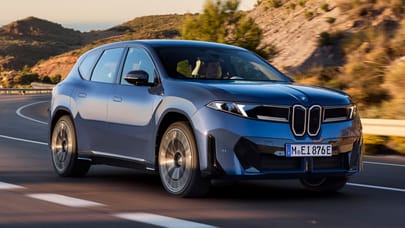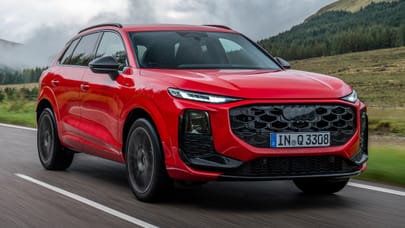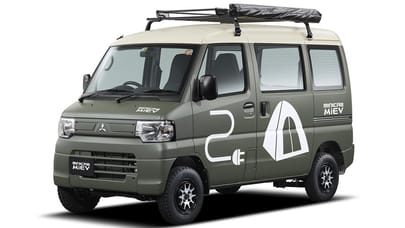

We're halfway between Dover and Calais when I learn the French word for horn. On a thin road in a secret tunnel, many metres under the English Channel, I appear to be playing a very slow game of chicken. "Le klaxon!" shouts my co-driver as he palms an imaginary steering wheel. I press the Ampera's quiet beeper, used to alert oblivious pedestrians. "Non! Le grand klaxon!" he says, now furiously kneading the air with his hand. So I give the bigger one a blast. The noise tumbles off towards France, while the oncoming - and somewhat slimmer - car swerves up the curved wall like a Mini in The Italian Job. I do the same, and we squeeze by with just a layer of paint to spare.
Photos: Joe Windsor-Williams
Advertisement - Page continues below
Wide stuff isn't usually allowed down here. But after much diplomacy, we find ourselves straddling the narrow lanes of the service road between the Chunnel's two railway tunnels. Safety crews are down here most days, though they rarely drive the whole length. Certainly no civvie has ever done this in an off-the-shelf car before. So with a thirsty editor with a sudden taste for French lager, I'm dispatched on a booze cruise with a TopGear twist. Eurotunnel's people set just one rule: the car must run on battery power while underground. Which means there's only one thing in our garage up to the job: the Ampera. We'll use petrol power for the drive down, then switch into pure battery mode for the tunnel. With some careful driving, we should make it to Calais and back to the office in London without fuelling or charging.

After the usual protocol - follow the motorway to Folkestone, peel off for the check-in booths - we're ushered down a side road before driving through a square hole in the wall. But we're blocked by thick, yellow steel doors. They swing open with a hiss, and we drive into an airlock chamber. It's like a Bond villain's bunker, all pipes and valves, with chevrons on the walls. The doors clunk shut before another set opens in front. My ears pop as the pressure jumps up.
When they started building the tunnels in 1988, the service road was the first to probe a route through the prehistoric chalk, running about a mile ahead of the other two. But it wasn't the first time someone tried to dig their way to the Continent. That honour goes to some ambitious Victorians who imagined ponies pulling carts through a damp shaft, coming up for air somewhere in the middle of the Channel. They got as far as Dover pier before giving up. The idea was then continually debated for the next hundred or so years. Some feared invasions. Others calculated that if a link existed during wartime - to ferry troops and kit - it would've shortened the length of WWII by up to two years. Finally, a plan was agreed, and the 31.4-mile tunnel (23.5 miles of which is sub-aqua - making it the longest undersea section of a tunnel in the world) was completed in 1994.
Advertisement - Page continues below
The excavated spoil increased the size of the British Isles by 90 acres. The void it left behind now stretches out in front of us, pouring downhill and around corners. We glide silently out of the airlock, and white striplights paint lines over the Ampera's roof. Gentle on the throttle, creep up to the 30mph speed limit. There might be proper road markings down here, but, at just 4.9 metres in diameter, it's uncomfortably tight. Thick roof wires zap 50,000 volts of French electricity back to Britain, while a giant silver tube supplies water to fire hydrants every few hundred yards. It feels like we've been shrunk and I'm being zipped down a fibre-optic network. The edges blur. White lines smudge. I'm humming. Is that a rat? What would it eat? How many ships are passing overhead? How much does the English Channel actually weigh? Is that a crack...?

At the deepest point, we're 250 metres beneath sea level and 75 metres under the seabed. As we descend deeper into the blanket of geology, things get muggy. But we've switched off the aircon to milk as much as possible from the battery. To be safe, I dab the brakes on the downhill bits, harvesting precious power from the regenerative system, and squeeze the throttle gently up slopes. Our tyre pressures squeeze up to 38psi in this heat, which helps reduce rubbery friction. So, for the first few miles, I actually gain range. Over in the States, celebrity denim fan Jay Leno claims to have done 11,000 miles without putting fuel in his Chevy Volt (the Ampera's rebadged American cousin), and on this evidence, it's tempting to believe him. Fully juiced, Vauxhall claims it'll do 50 miles on a single charge without assistance from the petrol engine. I reckon it'll do more today. It'll have to.

Through the walls comes a deep rumble. Either side of us the trains are blasting forward at up to 99mph, pushing along a bow wave of air as they go. If it weren't released through ducts in the roof, the shockwave would surge through the tunnels, exiting with a sonic boom strong enough to smash windows. At the other end of the carriages, there's a vacuum as the air is sucked away. If we were to open an adjoining door at the wrong moment, we'd be hoovered onto the tracks.
Thankfully, they're all sealed. But if an emergency occurred, rescue crews would arrive from both ends of this road in purpose-built vehicles at speeds of 50mph. They even have an autopilot mode, so they can squeeze past each other without slowing down. Once at the scene, they could evacuate 900 train passengers in three minutes or under, even in thick smoke.

Onwards into the gloom. The ceiling lights are off now, leaving our headlamp beams to chase away the shadows. Up ahead, the road bends around gradual corners, softening the vanishing point and giving me something to steer at. It took 11 boring machines to crunch through the rock, the last of which nosedived to avoid one coming the other way. It's still buried around the halfway point, which is where we stop for a rest. The lights flicker on. The air is dense. Fine concrete dust creates a haze in the orangey twilight. And the bare wall is covered in workmen's graffiti. "Dickie Dawkins - the mental health legend!" reads one. "Pigeons on cable tray?" asks another. We add our own, mostly unprintable contribution before setting off into our private underworld.
Advertisement - Page continues below
The only blockage comes shortly after, but, with horns successfully sounded, we're clear all the way to the border. It's only been an hour or two, but my pupils have turned into pixels, and our bilingual conversation is slowly dying. "Je suis bored," I say to Remy, my French guide and trained Chunnel driver. "Hmm," he replies. I ask if anyone's ever drifted off down here. It's easy to imagine sleepy drivers veering up the walls, though he's not willing to confirm. Is that another car up there? Or just the next section of lights? I'd put some music on, but that'd use up precious power. The readouts are telling me we've used 5.2kwh of charge from a potential 12.6, so with just a few miles to go before turning around, the delicate right-footery is paying off. We could just make this.

The next bit is slightly uphill, and as we close in on France, we pass through a large cavern containing two shabby Portaloos. Onwards. Out of the darkness comes another pair of yellow doors and a small set of traffic lights. We wait for clearance, enter the chamber, and finally the last set of doors fling open, flooding us with brilliant sunlight. It stings my face. Burns through my eyelids. So it's on with some sunnies, through the final archway and back into petrol mode along back roads. A quick customs check, and we're on our way to the cash 'n' carry. A generous crate of beer is rapidly loaded before we turn around and do it all again. That's 31.4 miles underground down, another 31.4 to go, and exactly half the charge remaining. I promise I'm not making this up.
Advertisement - Page continues below
There'll be no pausing for photos on the way back. Lots of stopping and starting isn't good for range. So with the Ampera back in stealthy battery mode - the electric motor always powers the wheels; the petrol engine only acts as its generator when needed - we go back underground. Easy on the throttle. Keep it on the centre line. Gather momentum, then knock it into neutral to save even more energy. I settle into a hypnotic rhythm. Remy settles into a nap. The thermometer rises, then slowly falls as we approach the surface again. Finally, with about a mile of charge to spare, more airlocks. More blinding light. And we're back on the public roads, petrol engine feeding the electric motor as we cruise to the London office. Alcohol is delivered and downed. And we become the first regular citizens to actually drive a production car to France and back. Our time? A speedy-ish 1hr 15mins on the return trip.
So there you go: a TG world record. Sound the klaxons!







